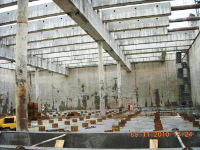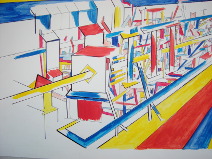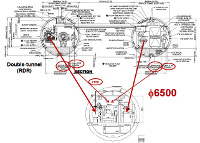 |
|
|
 |
SiD moving forward
This month's Research Director's Report was written by Jim Brau (University of Oregon) and Andy White (University of Texas at Arlington), who serve on the SiD Executive Committee and were co-organizers of the recent SiD workshop.

Participants in the Silicon Detector Collaboration Workshop met at the University of Oregon in Eugene last month to advance their work on the Detailed Baseline Design, to be published at the end 2012. They also discussed their contributions to the CLIC Conceptual Design Report, to be completed by August 2011. Image:Jim Brau |
The SiD (Silicon Detector) Collaboration met in a workshop at the University of Oregon in Eugene from 15-17 November to review progress, discuss plans, and further organise its effort for the Detailed Baseline Design (DBD) report due at the end of 2012. The workshop also reviewed and discussed contributions to the CLIC Conceptual Design Report (CDR), which is now to be completed by August 2011. A significant effort from SiD has been directed to the CLIC CDR, which has been of real benefit to ILC SiD as well, and will strengthen the effort on the SiD DBD.
Read more...
-- Jim Brau and Andy White for SiD
Research Director's Report Archive |
 |
|
|
 |
|
 |
Getting a vision of tunnels
Wilhelm Bialowons reports from the visit of the ILC civil facilities and siting group to the European XFEL and FLASH at DESY in Hamburg.

Inside the future European XFEL experimental hall.
Image: John Osborne |
Early November, four members of the Global Design Effort Conventional Facilities and Siting group and two guests from Japanese industry visited DESY in Hamburg, Germany, for two days. They wanted to find out more about the current state of the European X-ray Free Electron Laser (XFEL) civil construction and to get information about other relevant projects like DESY’s FLASH accelerator.
Read more...
-- Wilhelm Bialowons (DESY) |
 |
|
|
 |
A (CLIC) study in art

These images are the result of a successful exercise in mutual benefit. Taking a break from working on the upcoming CLIC Conceptual Design Report, CERN's Hermann Schmickler gave a presentation about the future collider to art classes in the Chataigneriae International School in Switzerland. The students aged from 15 to 17 years then came up with their own vision of CLIC — the images shown here are just two out of 40 submitted drawings. All of them were recently exhibited at CERN and one will be used on the cover of the CLIC CDR.

|
 |
|
|
 |
From People's Daily
13 December 2010
China's 1st deep underground lab now operational for dark matter
China's first deep underground laboratory was formally put into service in Jinpin hydropower station in Sichuan Province on Dec. 12, which means China now possesses an independent cutting-edge underground scientific research and experimental platform in physics.
Read more... |
|
From nature
10 December 2010
LHC plans extra year for Higgs hunt
Collider may run right through 2012 to find elusive particle.
Read more... |
|
From Spiegel
10 December 2010
"Science Slam"-Finale - Große Show mit Schlaumeiern
Hier wird das Referat zum Event: Beim "Science Slam" wetteifern Studenten und Doktoranden darum, wer besonders amüsant über Exotisches sprechen kann - von Quantenwissenschaft bis zur Stringtheorie.
Read more... (in German) |
|
From industrie.com
8 December 2010
Pour la science : Philippe Lebrun
Le mécanicien des particules.
... Clic aura pour vocation d’étudier de près les phénomènes découverts au LHC. Tout comme le projet concurrent ILC (International linear collider), qui réunit lui-aussi un impressionnant panel international de scientifiques.
Read more... (in French) |
|
|
 |
 |
|
|
 |
Evolving the ILC baseline: single main linac tunnel

Converting the ILC reference design into a design having a single main linac tunnel |
Two weeks ago I described the motivation and the process for evolving the baseline for the technical design we are undertaking over the next two years. That work will culminate in a Technical Design Report (TDR) at the end of 2012. Last week, I discussed the first of four proposed actions for "top-level change control" and I announced my decision to approve the proposal for the main linac operating gradient. Today, I describe the second of the proposed change actions, which has been stated as follows: “We propose to change the main linac tunnel configuration to one with only a single, accelerator-enclosure tunnel, thereby eliminating the support equipment tunnel proposed in the Reference Design. We propose to develop and include in the baseline two novel High-Level RF power source and distribution schemes ("KCS" and "DRFS") that are better suited to a single-tunnel solution than the scheme proposed in the RDR. A fall-back to the RDR HLRF Technology can be adopted should the R&D on KCS or DRFS not be considered successful.” I have considered and approved this baseline change, following the advice of the Change Evaluation Panel.
Read more...
-- Barry Barish
Director's Corner Archive |
 |
|
|
 |
NewsLine holiday schedule
NewsLine is taking a break for two weeks. Our next issue will be on 6 January. Happy holidays!
ILC Memo
2010-004
GDE Change Evaluation Panel - TLCC-2 – Decision Memo
2010-003
GDE Change Evaluation Panel - TLCC-1 – Decision Memo
ILC Internal Document
2010-050
BAW-1: ML Accelerator Gradient - Summary of Discussions and Proposal
arXiv preprints
1012.2792
Vertex Tracking at a Future Linear Collider
1012.2367
Precision Electroweak Measurements and Constraints on the Standard Model
1012.1730
Discrimination of SUSY breaking models using single-photon processes at future e+e- linear colliders
ILC-HiGrade Report
2010-007
2nd Sound as quench localisation tool
|
|

